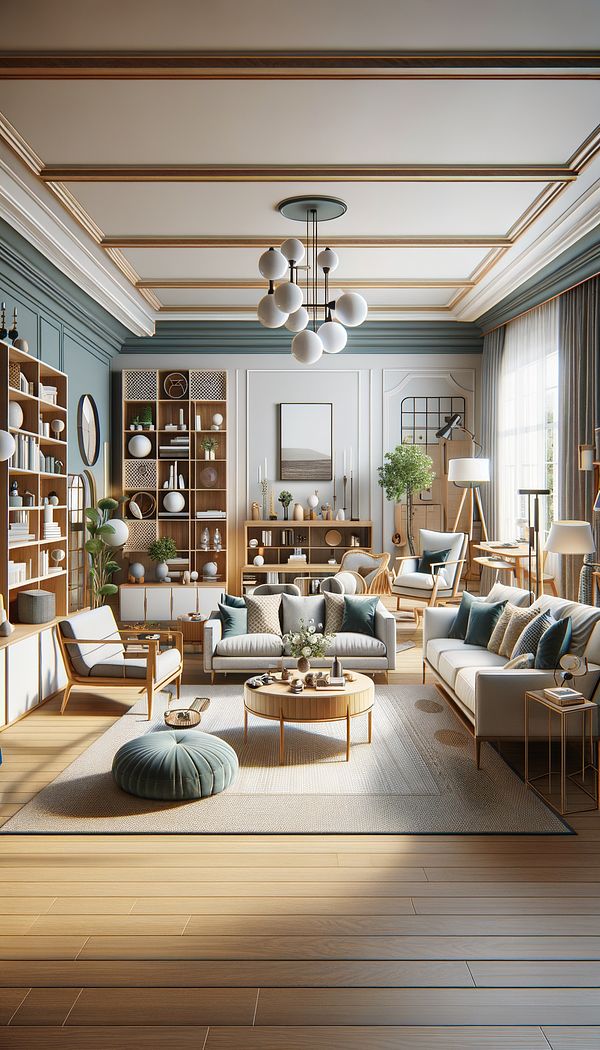What is Harmony?
Harmony is the aesthetic concord and pleasing coherence among various elements in a design.
Description
In the realm of interior design, harmony is a foundational concept that relates to the seamless blending and coherence of different design elements within a space. It's about creating a unified atmosphere where all components, such as color and patterns, furniture types, materials and textiles, and even architectural features, work together to produce a cohesive and aesthetically pleasing environment. Harmony often involves the thoughtful balance of contrasts, repetitions, and unity in design elements, enabling a space to feel complete and connected.
Achieving harmony is both an art and a science, requiring a keen eye for design and a good understanding of the space's functionality. Designers aim to harmonize the visual weight, scale, and proportion of objects, alongside their colors, textures, and patterns. This can involve blending styles in a way that they complement each other without overshadowing. Furthermore, harmonizing does not mean making everything identical; instead, it's about finding a balance that reinforces the design theme without compromising functionality and personal taste.
Harmony can dramatically affect the mood and feel of a space. When elements are in harmony, the space can evoke emotions of tranquility, comfort, and joy, making it more inviting and liveable. On the contrary, a lack of harmony can result in a disjointed and unsettling environment. As such, achieving harmony is crucial for creating spaces that are not only beautiful but also comfortable and functional.
Usage
An example of harmony in interior design could be a living room where the furniture, wall colors, and decorations all align with a coastal theme, using soft blues, beige, and white, complemented by materials like driftwood and linen. Here, harmony is achieved through a consistent theme, color palette, and the use of natural materials that tie the different elements together, creating a cohesive and relaxing space.
FAQs
-
Can harmony be achieved with contrasting elements?
Yes, harmony can be effectively achieved through the use of contrasting elements, as long as these contrasts are balanced and thoughtfully incorporated into the design. Contrasting colors, textures, or shapes, when used wisely, can add interest and depth to a space while maintaining a cohesive look.
-
Is harmony the same as uniformity?
No, harmony is not the same as uniformity. Harmony involves creating a cohesive look by blending different elements in a balanced way, while uniformity often implies sameness or repetition without variation. Harmony allows for diversity and uniqueness within a unified design.
-
How do I know if my space is harmonious?
A space is considered harmonious when it feels balanced, cohesive, and pleasing to the senses. You can assess this by looking at how well the various design elements such as color, texture, and form blend together, and whether the space reflects a clear, unified theme without any element feeling out of place or overwhelming.
Practical Application
To achieve harmony in your space, start by defining a clear design theme or concept. Next, carefully select colors, textures, and patterns that complement each other and the overall theme. Pay attention to the scale, proportion, and placement of furniture and decor. Incorporating repeating elements, whether in color, material, or motif, can also help in creating a sense of unity. Finally, always consider the balance between aesthetics and functionality to ensure that the space is not only beautiful but also comfortable and practical.
-
Materials & Textiles360 articles
-
Furniture Types599 articles
-
Color & Patterns154 articles
-
Decorating Principles & Elements330 articles
-
ReliefIn interior design, relief refers to a method of molding, carving, or stamping in which the design stands out from the surface.
-
Ball & ClawBall & Claw is a type of furniture leg that resembles an animal’s claw holding a ball.
-
RailroadedRailroaded refers to a method of fabric construction oriented horizontally rather than the traditional vertical orientation.
-
Festoon BlindA festoon blind is a type of window covering made from fabric that gathers into pleats when raised.
-
Yorkshire DresserA traditional type of wooden furniture originating from Yorkshire, England, characterized by its combination of shelving, drawers, and sometimes cupboards.
